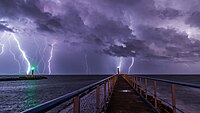
Photo from wikipedia
Abstract Temporal variation of the luminosity of seven natural cloud-to-cloud lightning channels were studied, and results were presented. They were recorded by using a high-speed video camera with the speed… Click to show full abstract
Abstract Temporal variation of the luminosity of seven natural cloud-to-cloud lightning channels were studied, and results were presented. They were recorded by using a high-speed video camera with the speed of 5000 fps (frames per second) and the pixel resolution of 512 × 512 in three locations in Sri Lanka in the tropics. Luminosity variation of the channel with time was obtained by analyzing the image sequences. Recorded video frames together with the luminosity variation were studied to understand the cloud discharge process. Image analysis techniques also used to understand the characteristics of channels. Cloud flashes show more luminosity variability than ground flashes. Most of the time it starts with a leader which do not have stepping process. Channel width and standard deviation of intensity variation across the channel for each cloud flashes was obtained. Brightness variation across the channel shows a Gaussian distribution. The average time duration of the cloud flashes which start with non stepped leader was 180.83 ms. Identified characteristics are matched with the existing models to understand the process of cloud flashes. The fact that cloud discharges are not confined to a single process have been further confirmed from this study. The observations show that cloud flash is a basic lightning discharge which transfers charge between two charge centers without using one specific mechanism.
Journal Title: Journal of Atmospheric and Solar-Terrestrial Physics
Year Published: 2018
Link to full text (if available)
Share on Social Media: Sign Up to like & get
recommendations!